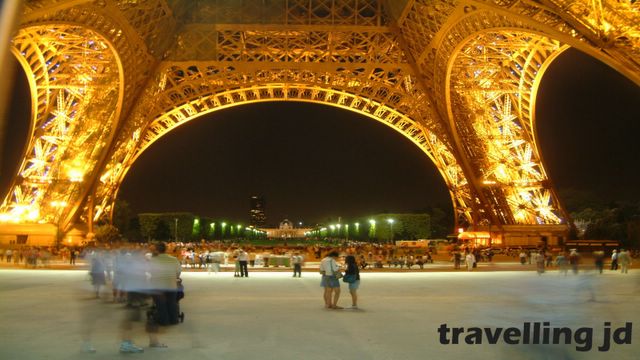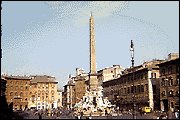
January 31, 2006

This piazza is a marvel of light and sculpture. It is exceptionally long and owes its shape to the ruins that formed it, for under the buildings that surround Piazza Navona are the remains of the Circus Domitianus, Domitian's stadium -- a part of which can be seen if you leave the piazza by the north exit and turn left. The piazza marks the area for the races in the stadium. It features many fine old buildings, a beautiful church and three stunning fountains. (Normally one would be happy if a piazza even had just one.)
It was in the arena that the twelve-year-old Christian, Agnes, refused to marry a pagan and was thus martyred on the spot where the church of Sant'Agnese ("uhn-YEH-seh") is located. In ancient times the stadium was the site of the Agonal games, from which the present piazza takes its name by corruption from "in agone" to "n'agone" to "navone" and finally "navona".
In the centre of the piazza is Bernini's most spectacular fountain, la Fontana dei Fiumi (= rivers, "FYOO-mee"), erected in 1651. It features a central rocky structure that supports an obelisk that was an ancient Roman imitation of the Egyptian form. Around this structure are four giant statues by Bernini's pupils following his designs representing the Nile, the Danube, the Ganges, and the Rio della Plata, each representing one of the four quarters of the world. These statues have quite lifelike positions and have such movement to them that they seem to be gesticulating. (from Romainteractive.com)
- clubs -
- blogs -
- travel tools - - travel blogs - - travel links - - france - - air - -newspapers- -Travel Magazines- - cameras & things - - sports - - financials - - archives -
Glencoe District Lions
blamblog
meredith
Ice Queen
Government of Canada Consular Affairs-Warnings and other useful info
USA Bureau of Consular Affairs- Travel Information
Southwest Middlesex
Weather Underground
World Time
Travel Maps
Restroom Ratings
Translation
Currency Calculator
Slow Travel
Top Travel Blogs
TravelBlog
Vagabonding
Aircanada Vacations
Bel Air Travel
Book It For Less
Commodore Travel Oshawa
Elderhostel
Exit Travel
Flight Centre
Itravel 2000
LastMinuteClub
Renaissance Travel
RedTag Vacations
Sears Travel
Travel Discounters
Vacations to Go -Cruises
Bonjour Paris
TVG
The BUS
The Bus
Apt.Rental La Clusaz
Ski Pass Reservation
Ecole de Ski Francais
Tourist Office of La Clusaz
National Tourist Office-France
Hotel Reservations-France
Air Transat
Skyservice
SYDNEY MORNING HERALD
CHICAGO TRIBUNE
Detroit Free Press
The Globe and Mail
The Guardian
The London Free Press
MAIL & GUARDIAN S.AFR.
Montreal Gazette
Cape Times,Cape Town
Los Angeles Times
LE MONDE
FIGARO
LE PARISIEN
La Repubblica
Toronto Sun
Washington Post
London Times Online
Have Children Will Travel
Connected Traveler
Journey Woman
Ticked-Off Tourist
TimeSharer Magazine
Transitions Abroad
Travel and Leisure Mag.
Travel With A Challenge
digital camera reviews
Sharper Image
PGA
NBA
tsx
November 2004
December 2004
January 2005
February 2005
March 2005
April 2005
May 2005
June 2005
July 2005
August 2005
September 2005
October 2005
November 2005
December 2005
January 2006
February 2006
March 2006
April 2006
May 2006
June 2006
July 2006
August 2006
September 2006
October 2006
November 2006
March 2009
